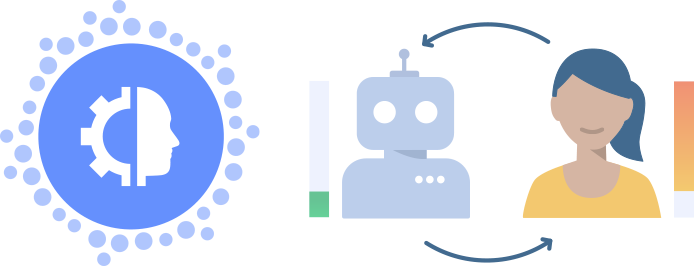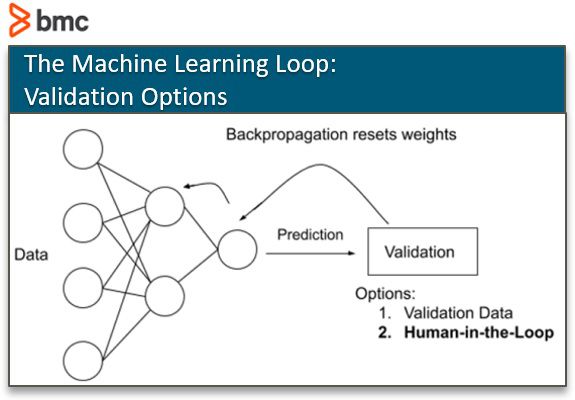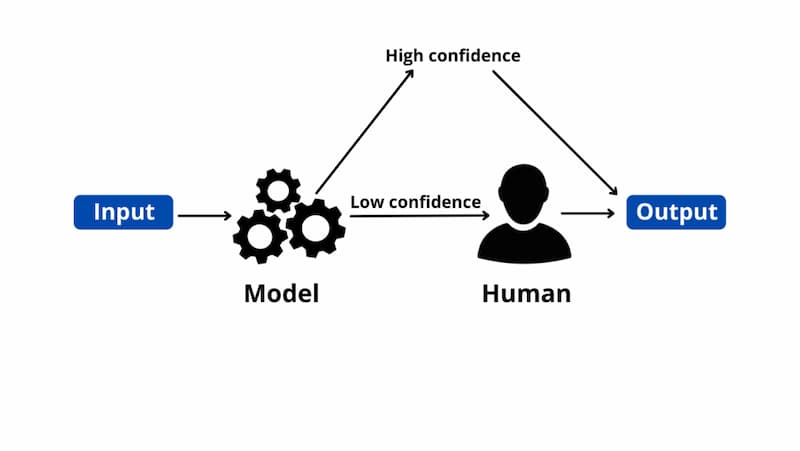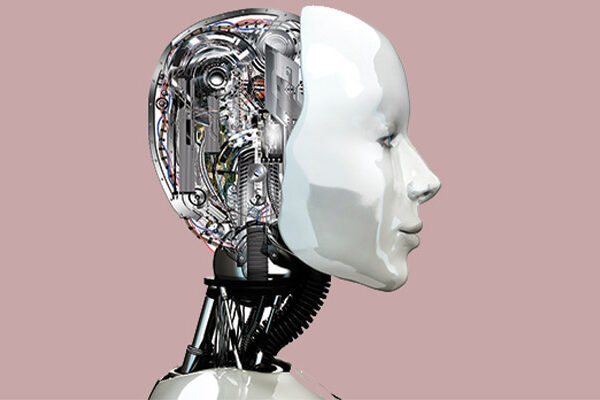Most machine learning models rely on human-prepared data. But human-machine interactions don’t stop there—the most powerful systems are built in such a way that they allow both parties to continuously interact through a mechanism commonly referred to as a “human-in-the-loop” (HITL). Humans annotate or label data, which are then given to machine learning algorithms, which learn from them and make decisions based on those predictions. Humans are then also involved in tuning the model to improve its accuracy. This article will introduce the concept of Human-in-the-Loop and how you can use it to your advantage.
Table of Contents
What is Human-In-The-Loop?
Basically, it can be said that Human in the Loop (HITL) is the process of harnessing the power of the machine and human intelligence to create machine learning-based artificial intelligence models.
HITL describes a process where a machine or computer system cannot solve a problem and requires human intervention, such as participating in the training and testing phases of building an algorithm to create a continuous feedback loop that enables the algorithm to give better results every time.
Finally, when the machine learning algorithm fails to make the right decision or gives the wrong decision, these people test and validate the model by scoring its output.
When Should Use Human-In-The-Loop Machine Learning?
Human-in-the-loop machine learning can be used for any deep learning AI project, including natural language processing (NLP), computer vision, and transcription. It is especially useful in the following situations:
- When the cost of algorithmic error is high, such as machine algorithms used in medical diagnosis, prognosis, and treatment.
- Humans often make better judgments than machines when lacking currently available data. Once it has a certain amount of training and test data, the machine can take over and make better judgments.
- When you’re looking for little data, such as using image recognition to find photos of specific faces. In this case, machine intelligence can save a lot of time and cost by eliminating images that cannot confidently describe the person and shrinking the pool of images. The task can then be passed to a human in the final stage to sort through dozens of images of similar faces to find the correct one.
Why Is Human-In-The-Loop Machine Learning Used?

If you have a sufficient number of datasets, ML algorithms can easily make decisions with the accuracy learned from those datasets. But before the machine needs to learn from a certain amount and quality of datasets, how to correctly identify the right criteria and thus come up with the right results.
In this context, human-in-the-loop machine learning is used to combine human and machine intelligence into a continuous loop in which ML algorithms are trained, tested, tuned, and validated.
In this cycle, with the help of humans, machines become smarter, more trained, and more confident to make fast and accurate decisions when used in real life and to help train algorithms.
How Human-In-The-Loop Machine Learning is Used?
Human-in-the-loop is basically integrated through two machine learning algorithmic processes – supervised learning and unsupervised learning. In supervised machine learning, ML experts use labeled or annotated datasets to train algorithms so that they can make correct predictions in real-world applications.
On the other hand, in unsupervised machine learning, the learning algorithm is not tagged and is left to find structure in the input and store the data in its own way.
In HITL, initially, humans label the training data for the algorithm, which is then fed into the algorithm to enable the machine to understand various scenarios.
Subsequently, the human also checks and evaluates the results or predictions of the ML model validation, and if the results are inaccurate, the human adjusts the algorithm or data and feeds it into the algorithm again to make the correct prediction.
Why Human-In-The-Loop Computing is the Future Of Machine Learning?
It is impossible to do machine learning without human input. Algorithms cannot learn everything unless provided according to their compatibility. For example, machine learning models cannot understand raw data unless humans interpret and enable machines to understand raw data.
Here, the data labeling process is the first step in creating a reliable model trained by the algorithm, especially when the data is available in an unstructured format.
In fact, algorithms cannot understand unstructured data that is not properly labeled, such as text, audio, video, images, and other content.
Importance of HITL in ML

- Improve accuracy on rare datasets
As mentioned above, traditional machine learning models require a large number of labeled data points to produce accurate results. Therefore, machine learning models are not very useful in the absence of data.
For example, if you are looking for specific information in a language that is only spoken by a few thousand people, the machine learning algorithm might not find many examples to learn from. Therefore, HITL methods help to ensure accuracy on rare datasets.
Or take healthcare as an example. In this area, there has been – and always has been – a lot of debate about whether systems should be automated. A 2018 Stanford study found that human-in-the-loop AI models are better than AI itself or human doctors themselves.
These systems can help improve accuracy while maintaining human-level work standards. This can be applied to many industries and change the way people work around the world!
- Improve safety and precision
In many cases, you need artificial intelligence to provide human-level precision for safety and accuracy. For example, when manufacturing critical components for vehicles or aircraft, equipment must meet standards. While machine learning is helpful for inspection, it is better to have a human monitor the system.
How to install HITL AI Systems
There are many ways to install a HITL-enabled AI system in your company. Unless you want to read an entire book about it, the easiest way is to use a piece of software that has this process in mind.
Levity’s automation software is built around this concept: we know that many companies simply don’t have enough data to achieve near-perfect performance from the start, but often enough to get reasonable results. By adding HITL to the mix, this performance can be greatly improved—both instantaneously and chronically, as every intervention is an important part of ongoing training.
Final Words
The goal of humans in the loop is to achieve goals that neither humans nor machines can achieve alone. When machines cannot solve a problem, humans need to step in and intervene. This process creates a continuous feedback loop. With constant feedback, the algorithm learns and produces better results every time.
Generally, there are two machine learning algorithms that can integrate HITL methods. This includes supervised and unsupervised learning.
In supervised learning, experts use labeled datasets to train algorithms to generate appropriate functions. These can then help draw new examples. Doing so will allow the algorithm to correctly determine the function of the unlabeled data.
In unsupervised learning, an unlabeled dataset is fed into the algorithm. Therefore, they need to learn on their own how to find structure in unlabeled data and memorize it accordingly. This is a man-in-the-loop deep learning approach.




